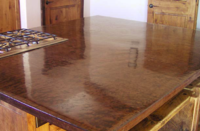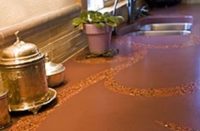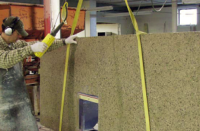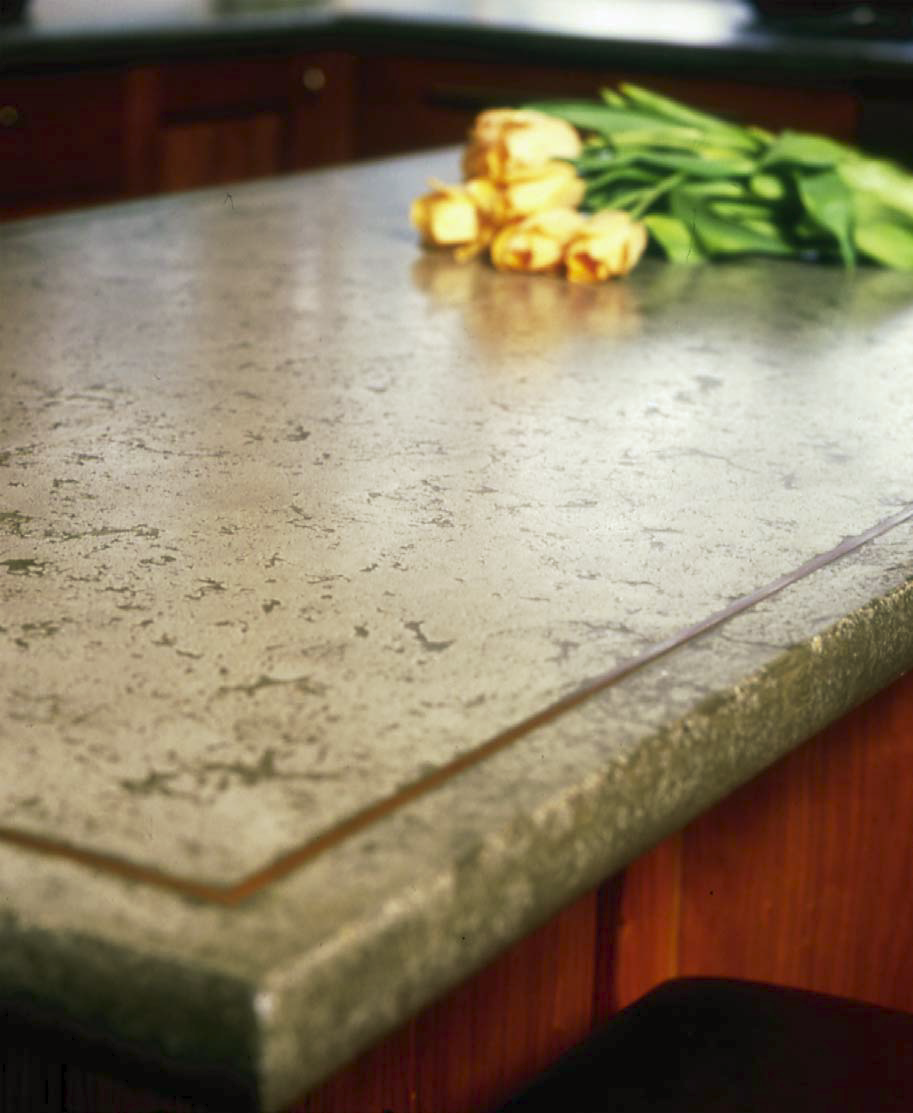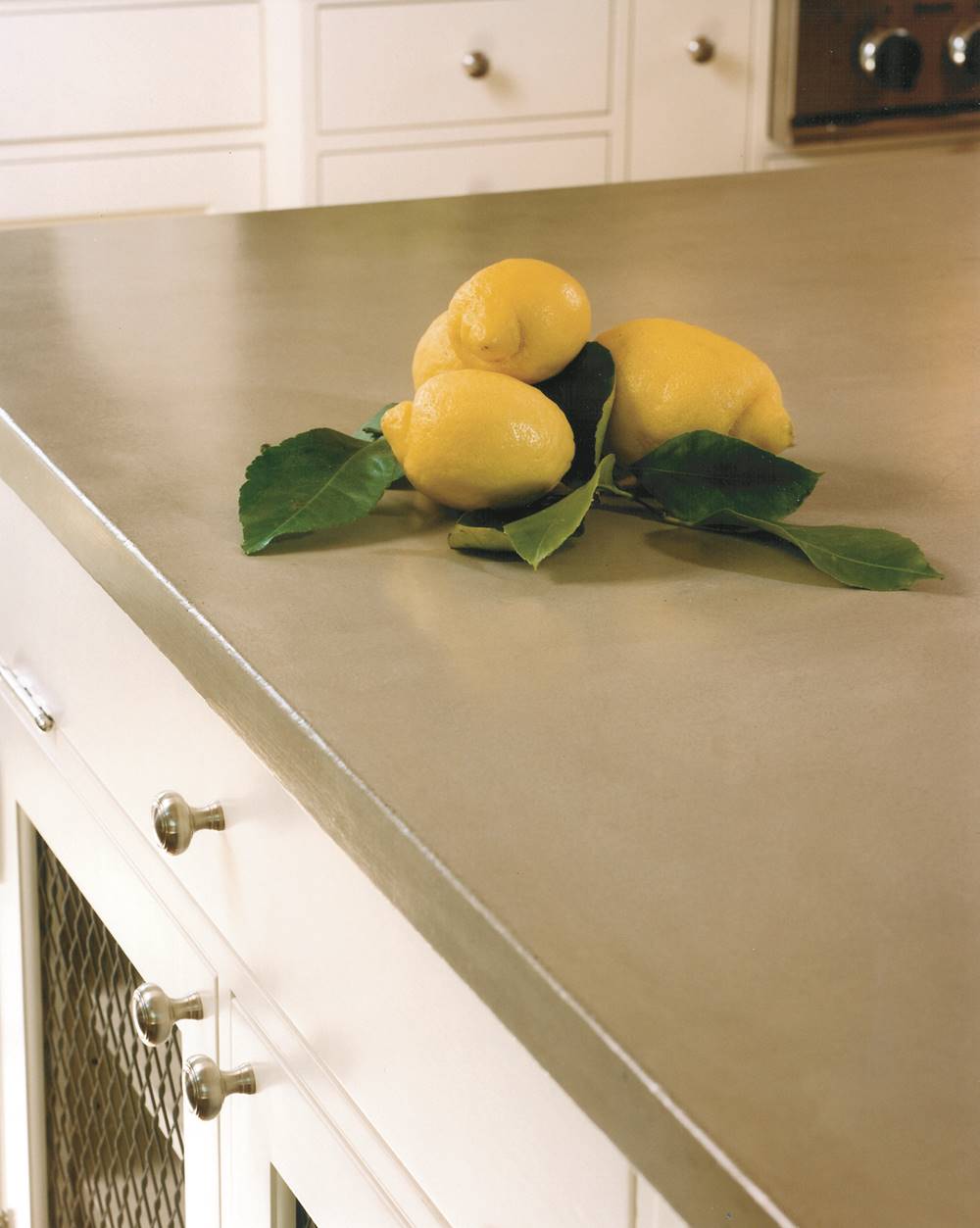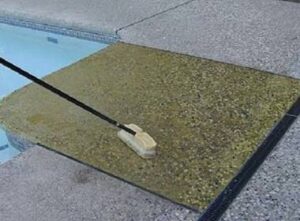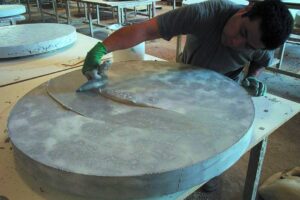The growing popularity of concrete countertops has prompted manufacturers to upgrade their sealers, making them more stain-resistant, scratch-proof and easier to maintain than ever.
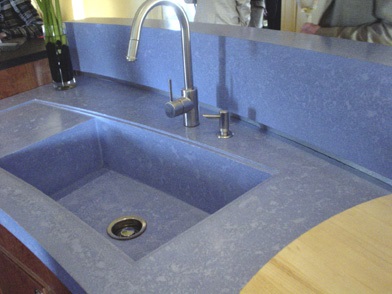 While decorative concrete contractors may find it easy to promote custom concrete countertops these days, questions about food preparation, FDA ratings and safety may not be resolved so easily.
While decorative concrete contractors may find it easy to promote custom concrete countertops these days, questions about food preparation, FDA ratings and safety may not be resolved so easily.
Contractors should be sure they can answer these fundamental concerns as concrete countertops become more commonplace in America’s kitchens. As always, job No. 1 is to understand the products you’re working with: how they perform, how they stand up over time, and how they can be maintained.
“There is no ideal sealer because there are always trade-offs,” says Lane Mangum of the Raleigh, N.C.-based Concrete Countertop Institute. She cites performance, stain resistance, aesthetics, ease of application and cost as some of the factors a contractor must consider.
“If you’re able to offer a wide range of performance capabilities, you’re able to reach a wider customer base,” Mangum says.
Contractors who want a natural look often opt for a penetrating sealer, but penetrating sealers won’t repel stains as well as others do. A stain-resistant sealer may be more prone to scratching. They also tend to be time-consuming and tricky to apply, Mangum says. Some concrete countertops can be cleaned with bleach, while others can’t.
Pros and cons
Concrete countertop expert Buddy Rhodes, of Buddy Rhodes Studio in San Francisco, has been experimenting with sealers for years. All have their pros and cons. He has settled on using a penetrating sealer, then a water-based topical sealer that provides a satin finish rather than a high-gloss sheen. A beeswax paste is the “sacrificial” coating on top of that.
“There are stronger sealers out there, but they take a long time to set up and they’re hard to apply and they’re toxic,” he says. “So this one’s a nice balance — it’s easy to apply and friendly to the homeowners.”
Rhodes offers three finishes: a “hard-troweled” finish, in which the trowel marks are left on the surface, a “pressed” finish, which is made with a mold that leaves voids filled with one or more colors, and a “ground” finish, where the troweled surface is ground away exposing the aggregate beneath.
 He says maintenance is basically the same for all three finishes. He recommends homeowners apply his food-grade beeswax topping every month or two. This protects the sealer, prevents stains and provides a pleasant patina. Also, clean up spills quickly and use a cutting board because the sealer isn’t completely scratch-proof, he says.
He says maintenance is basically the same for all three finishes. He recommends homeowners apply his food-grade beeswax topping every month or two. This protects the sealer, prevents stains and provides a pleasant patina. Also, clean up spills quickly and use a cutting board because the sealer isn’t completely scratch-proof, he says.
Thin to win
Brad Berg of Architectural Enhancements of Montgomery, Minn., says he offers a countertop mix that has high portland-cement and polymer content, making it very tight and nonporous, “So, when you trowel it off, it has a sheen to it on its own without being polished,” he says. “Even without a sealer it’s really resistant.”
He says contractors tend to have their favorites, but he believes in using a thin but strong layer of epoxy topped with a urethane with performance capabilities of 10,000 psi. This provides a scratch-proof sheen (matte or gloss) that resists stains from coffee, ketchup, wine and other foods. “With the proper sealers, they’re almost bulletproof,” he says.
Consult the FDA
But are they safe? The Food and Drug Administration doesn’t approve sealers per se, but it does offer FDA ratings for sealers.
 Nancy Pierson, CEO of Sound Specialty Coatings Corp., a manufacturer of environmentally safe sealants, paint and other products, says customers should ask whether a product complies with FDA rating standards. For example, her company’s Aquaply FDA Sealant is rated under FDA 21 CFR 175.300, which covers resinous and polymeric coatings, and 21 CFR 176.170.
Nancy Pierson, CEO of Sound Specialty Coatings Corp., a manufacturer of environmentally safe sealants, paint and other products, says customers should ask whether a product complies with FDA rating standards. For example, her company’s Aquaply FDA Sealant is rated under FDA 21 CFR 175.300, which covers resinous and polymeric coatings, and 21 CFR 176.170.
“If they can’t answer that question, either demand that they make it food-safe, or go to Google and find a product that is,” she says. That goes not just for the sealants, but the colorants too.
Pierson recalls fielding a call from a contractor using Thompson’s Water Seal on a concrete countertop. “You can’t even use that inside, much less on a countertop.” She’s also heard of people using silicone sealants, which are a no-no in a food environment.
There are plenty of safe products that perform well, she adds; it’s all a matter of education. “You don’t have to give up artistry for the sake of food safety. You can have beauty and you can have functionality, and it can also be food-safe.”
No easy answer
Jeffrey Girard, president of The Concrete Countertop Institute, wrote in a blog on Concretenetwork.com that there is “no easy answer” for sealers. “High-performance solvent-based sealers can be the least environmentally friendly because most of them contain volatile organic compounds. Many manufacturers have come out with water-based sealers, but these sealers tend to be less effective and more problematic than their solvent-based counterparts.”
He also wrote that fears about countertops being unsanitary are unfounded. The surface should have no pinholes or voids that can trap dirt, food or other debris. Sealers provide a waterproof barrier. Some sealers are even enhanced with antimicrobial products that prevent bacteria from surviving on the surface.
Concrete countertops can also stand up to common kitchen situations, but as always, it’s important to know what products perform the best. Sometimes, you just need common sense. If you cut directly on a concrete countertop, you’re likely to scratch the surface and dull your knife. Use a cutting board.
A hot pot may cause cracking or yellowing of the sealer. Some sealers can tolerate more heat than others. It is always the recommendation to use trivets.
Performance is imperative
 With concrete countertop work going for $100 a square foot, it’s critical for contractors to know their stuff. Some look at what they can charge and think countertops are easy money. But Mangum points out that floors are one thing, countertops are quite another. “The precision required is an order of magnitude different,” she says.
With concrete countertop work going for $100 a square foot, it’s critical for contractors to know their stuff. Some look at what they can charge and think countertops are easy money. But Mangum points out that floors are one thing, countertops are quite another. “The precision required is an order of magnitude different,” she says.
Because the concrete countertop industry is relatively young, it pays for contractors to differentiate themselves from the crowd. It does this by providing references, samples of work and product tests under a number of different conditions.
“They’re countertops first,” Mangum says. “They happen to be made out of a wonderful, versatile material — concrete — but they need to perform like countertops.”
Questions from Readers
Question
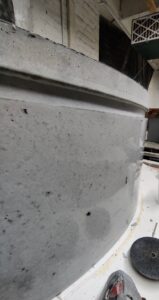
How do you remove that glossy look after a concrete countertop is demolded? It’s very glassy looking and I want to take it off. Here is a picture of the fire pit I’ve been working on.
Answer from Concrete Decor
There are a couple of methods for removing the gloss. One way of doing this is to grind the surface with a 100-grit polishing pad using an angle grinder. The second way is using a surface profiler or mixing a 15% to 20% muriatic acid/water solution. I prefer using the surface profiler because it essentially suspends the acid in a gel. This prevents acid from absorbing into the surface and damaging the concrete surface. Also, the gelled acid will hold onto a vertical surface which allows it to do its job.
